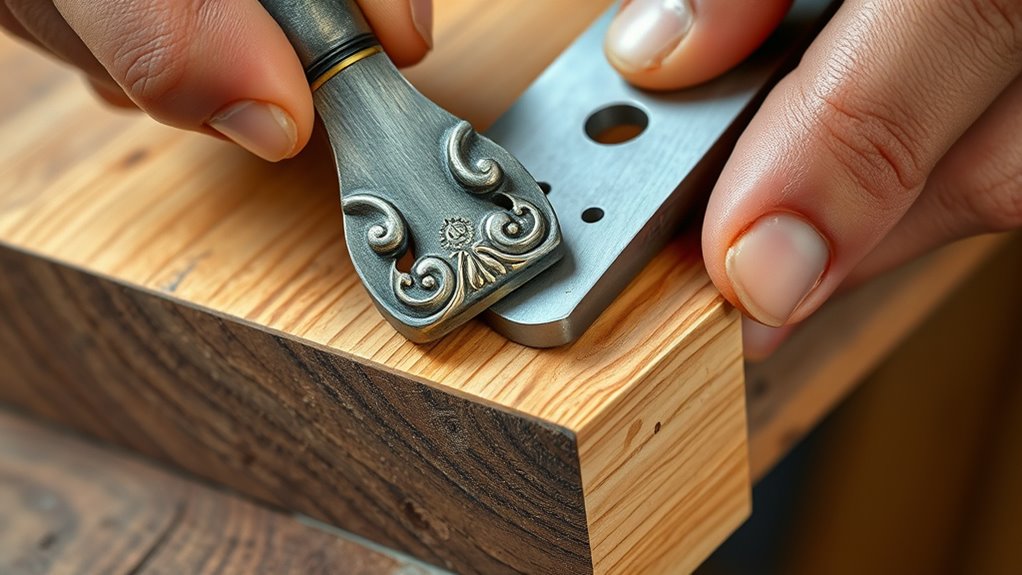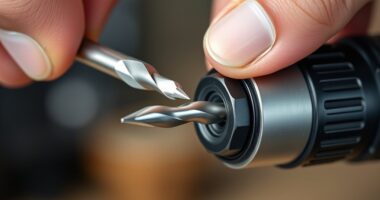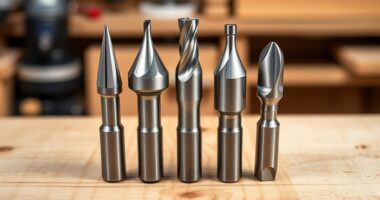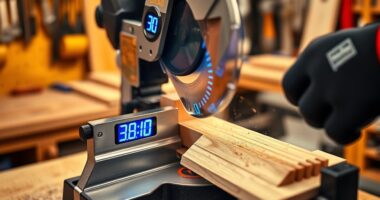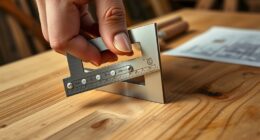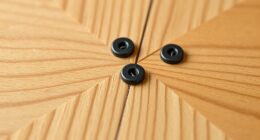To create perfect edge profiles with a scratch stock, start by shaping a blade to match your desired design through filing or grinding. Secure the blade in a sturdy wooden body that fits comfortably in your hand. As you guide the tool along your workpiece, apply steady pressure and follow the profile closely, working slowly for precision. If you keep practicing, you’ll master consistent, professional-looking moldings—continue on to learn more techniques.
Key Takeaways
- Select or craft a blade shaped to match your desired profile for precise edge shaping.
- Securely attach the blade to a sturdy wood body, ensuring stability and accurate control during use.
- Adjust the blade’s position and angle to match the intended profile, then secure it firmly in the scratch stock.
- Use steady, even pressure and follow the profile closely, making small passes to achieve a smooth, consistent edge.
- Regularly check the profile during shaping, filing or grinding the blade as needed for fine-tuning and perfect results.

Creating perfect edge profiles is essential for achieving a polished and professional finish on your woodworking projects. When it comes to crafting corners shaping or decorative moldings, a scratch stock tool can be your best ally. Unlike mass-produced moldings, scratch stocks give you the flexibility to create custom profiles that fit your specific design needs. With a little practice, you’ll find that this simple hand tool allows you to produce precise, consistent edges that elevate your craftsmanship.
Creating custom edge profiles with a scratch stock elevates your woodworking craftsmanship.
The beauty of using a scratch stock lies in its versatility. You can easily modify the cutting blade to match any profile you want, whether it’s a rounded corner, a chamfer, or an intricate decorative molding. To get started, you’ll need a sturdy piece of wood for the body, a sharp cutting blade, and a way to secure the blade at the desired profile. Once assembled, you can shape the blade to match the profile you envision by filing or grinding it to the right contour. This customization means you’re not limited by pre-made moldings; instead, you’re in complete control of your design.
When shaping corners or decorative moldings, it’s important to pay attention to the profile’s consistency across the entire length. As you run the scratch stock along the edge of your material, keep a steady hand and maintain even pressure. This will ensure a smooth, uniform profile without unwanted ridges or dips. For corners shaping, you might need to work slowly, taking small passes to gradually refine the curve or edge. For decorative moldings, the key is to follow the profile closely, adjusting your angle and pressure as needed to match the intended design. Additionally, maintaining proper color accuracy can help you better visualize how the finished molding will look under different lighting conditions, ensuring your profile matches your design intentions.
Using a scratch stock also allows you to create detailed moldings that may be difficult with power tools. Because you’re guiding the tool by hand, you can easily follow complex curves and contours, adding a custom touch that’s difficult to replicate with commercial profiles. This method is especially useful for reproducing original or period-specific molding styles, giving your project a unique, handcrafted character. Over time, you’ll develop a steady hand and an eye for detail, making your decorative moldings more refined and professional-looking.
Frequently Asked Questions
Can Scratch Stocks Be Used on Curved or Irregular Edges?
You might wonder if scratch stocks can handle curved or irregular edges. While they excel at creating precise edge profiles, their edge profile versatility is limited on complex curves. For curved edge techniques, you’ll need to adapt your approach or use specialized tools. Scratch stocks work best on straight or simple edges, so for intricate curves, consider alternative methods to achieve the desired finish.
What Materials Are Best Suited for Making Scratch Stocks?
When choosing materials for making scratch stocks, you want options that balance ease of shaping with tool durability. Hardwoods like maple or oak are excellent choices because they resist wear and can be precisely shaped. Avoid softer woods that wear down quickly, compromising your edge profiles. Your goal is to select materials that provide stability and longevity, ensuring your scratch stock remains effective and reliable for detailed work.
How Do I Maintain and Sharpen the Scratch Stock Blade?
To maintain your scratch stock blade, regularly perform blade sharpening using a fine file or sharpening stone to keep the edge keen. Follow maintenance tips like cleaning the blade after each use and applying a light coat of oil to prevent rust. Sharpen the blade at the correct angle, ensuring a smooth, even edge. Proper upkeep guarantees precise edge profiles and extends the life of your scratch stock.
Are Scratch Stocks Suitable for Outdoor or Weather-Resistant Projects?
Scratch stocks are suitable for outdoor or weather-resistant projects because they can be made from durable materials like hardwood or metal, offering good weather resistance. You can achieve outdoor durability by finishing the edges with protective coatings or sealants. While scratch stocks work well for shaping and profiling edges in outdoor projects, make certain you select weather-resistant materials and finish them properly to withstand moisture and environmental elements effectively.
Can Scratch Stocks Be Customized for Specific Edge Profiles?
Scratch stocks can be customized for specific edge profiles, giving you great control over your project’s look. The key is exploring your material selection and available customization options. With a little patience, you can precisely shape edges to match your needs. This flexibility helps you craft flawless finishes and perfect profiles, making your woodworking both practical and professional. Customization options truly release your creative potential.
Conclusion
Mastering edge profiles with a scratch stock elevates your woodworking projects, giving them a polished, professional look. Did you know that custom edge profiles can increase the value of handcrafted furniture by up to 15%? By honing this skill, you not only improve your craftsmanship but also add a unique touch that sets your work apart. So, keep practicing, experiment with different profiles, and enjoy the satisfaction of creating beautifully detailed edges that impress every time.
